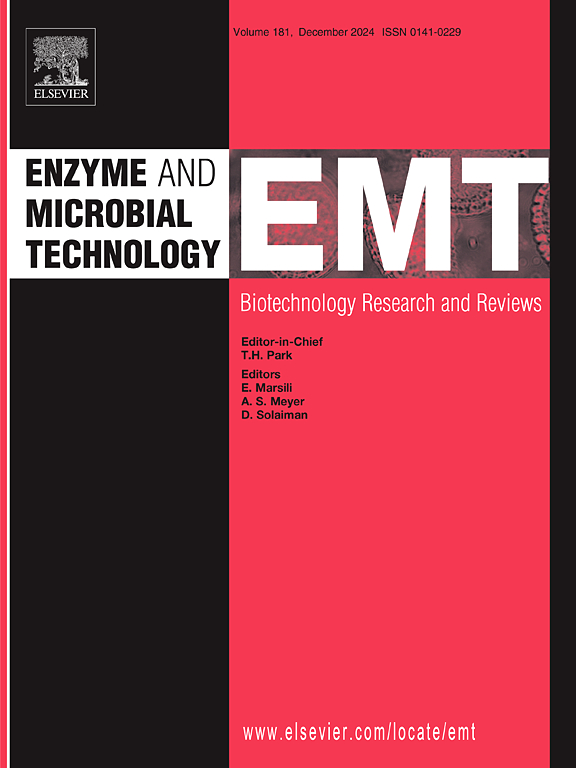Improved total carotenoid content from Planococcus plakortidis NIOT3 through microwave assisted extraction and genome-guided pathway annotation
IF 3.7
3区 生物学
Q2 BIOTECHNOLOGY & APPLIED MICROBIOLOGY
引用次数: 0
Abstract
With an increasing demand for natural colorants, marine microbes have become attractive targets for novel natural colorants like carotenoids. Microbial carotenoid extraction by green approach is advantageous over traditional methods which minimize energy usage and reduce extraction time. In the current study, an orange pigmented marine bacterium Planococcus plakortidis NIOT3 was isolated from the Sesostris bank of Arabian Sea and found to produce desirable level of total carotenoids (320 ± 24 µg/g DW) when grown in rich medium. An energy efficient green approach using Microwave Assisted Extraction was evaluated for carotenoid yield by one factor and statistical optimization of the MAE process conditions including exposure time, alkali concentration and Solid:Liquid ratio which resulted in a 3.26 fold increase in total carotenoid content of 2835 ± 152 µg/g DW. Genome sequencing and annotation revealed genes that are involved in C30 carotenoid biosynthesis. C30 carotenoids like glycosylated diapolycopene and methyl-5-glucosyl-5,6-dihydro-apo-4,4’-lycopenoate produced by NIOT3 were identified by LC-MS analyses as major products. Additionally, LC-MS analysis revealed a minor product with a molecular weight of m/z of 568.84 which corresponds to zeaxanthin, a C40 carotenoid. The study highlights the biotechnological potential of P. plakortidis in carotenoid production.
通过微波辅助提取和基因组引导通路注释提高高原Planococcus plakortidis NIOT3的总类胡萝卜素含量
随着对天然着色剂需求的增加,海洋微生物已成为类胡萝卜素等新型天然着色剂的有吸引力的目标。微生物类胡萝卜素绿色提取方法与传统方法相比具有优势,可以最大限度地减少能源消耗和提取时间。在目前的研究中,从阿拉伯海Sesostris bank of Arabian Sea中分离出一种橙色色素海洋细菌Planococcus plakortidis NIOT3,发现在富培养基中培养时产生理想水平的总类胡萝卜素(320 ± 24 µg/g DW)。通过对微波辅助提取工艺条件(曝光时间、碱浓度、料液比)的单因素优化和统计优化,评价了高效节能的绿色微波辅助提取法的类胡萝卜素得率,总类胡萝卜素含量为2835 ± 152 µg/g DW,提高了3.26倍。基因组测序和注释揭示了参与C30类胡萝卜素生物合成的基因。通过LC-MS分析鉴定了NIOT3产生的C30类胡萝卜素,如糖基化的双番茄红素和甲基-5-葡萄糖基-5,6-二氢-载脂蛋白-4,4 ' -番茄红素。此外,LC-MS分析显示一个小产物,分子量为568.84 m/z,对应于C40类胡萝卜素玉米黄质。该研究强调了plakortitis在类胡萝卜素生产中的生物技术潜力。
本文章由计算机程序翻译,如有差异,请以英文原文为准。
求助全文
约1分钟内获得全文
求助全文
来源期刊

Enzyme and Microbial Technology
生物-生物工程与应用微生物
CiteScore
7.60
自引率
5.90%
发文量
142
审稿时长
38 days
期刊介绍:
Enzyme and Microbial Technology is an international, peer-reviewed journal publishing original research and reviews, of biotechnological significance and novelty, on basic and applied aspects of the science and technology of processes involving the use of enzymes, micro-organisms, animal cells and plant cells.
We especially encourage submissions on:
Biocatalysis and the use of Directed Evolution in Synthetic Biology and Biotechnology
Biotechnological Production of New Bioactive Molecules, Biomaterials, Biopharmaceuticals, and Biofuels
New Imaging Techniques and Biosensors, especially as applicable to Healthcare and Systems Biology
New Biotechnological Approaches in Genomics, Proteomics and Metabolomics
Metabolic Engineering, Biomolecular Engineering and Nanobiotechnology
Manuscripts which report isolation, purification, immobilization or utilization of organisms or enzymes which are already well-described in the literature are not suitable for publication in EMT, unless their primary purpose is to report significant new findings or approaches which are of broad biotechnological importance. Similarly, manuscripts which report optimization studies on well-established processes are inappropriate. EMT does not accept papers dealing with mathematical modeling unless they report significant, new experimental data.
 求助内容:
求助内容: 应助结果提醒方式:
应助结果提醒方式:


